Advancing Technology
Webster University’s School of Communications is home to some of the most advanced communications technology found at any college in the Midwest, offering students access to the same equipment used by many of the top film, video, sound recording and game design companies in the country. The school recently added the first virtual cinema video wall in the region and a state-of-the-art recording studio suite, including a Dolby Atmos studio, to its existing programs and facilities. The School of Communications at Webster University is providing students hands-on training with cutting-edge tools in addition to deep immersion in industry-standard techniques.
Transcript
[Music]
Text on screen: Webster University
[Footage of the hallway in Sverdrup morphs into a montage of clips from the School of Communications, including a sound board, a student writing on a whiteboard and someone working on a computer.]
Text on screen: School of Communications
[Music fades and continues in the background, with an aerial shot and an exterior shot of the Sverdrup building cutting to an interview shot.]
Eric Rothenbuhler: We are in the west wing of this Sverdrup building that just remodeled as a state-of-the-art media production and communication education facility.
Text on screen: ERIC ROTHENBUHLER Dean, School of Communications
[Footage of a large screen in the soundstage before cutting to another interview shot of Aaron Aubuchon sitting in a theatre seat]
Aaron Aubuchon: We turned it former TV studio into a soundstage. We have a space that we can build things, so now we can actually put sets in that soundstage.
Text on screen: AARON AUBUCHON Associate Dean, School of Communications
We have an LED wall, so we could do virtual cinema production. We have an isolated audio facility. We've also updated some classrooms for gaming and animation.
[Footage of the LED wall, the audio mixing facility and various classrooms for other visual elements.]
[Music fades from the background into full level as there are a montage of clips from the Sverdrup building, including additional facilities and technology. The music fades back into the background as Rothenbuhler begins speaking.]
Rothenbuhler: We may have particular labs optimized for one degree program or another, but between classes the students are sitting next to each other.
[A close-up interview shot of Rothenbuhler.]
They see what each other is doing. They get curious, they start collaborating, and that prepares them for working in the industry.
[Music becomes full volume again with a long, sped up clip of the LED wall, before fading again, and cuts to video games design and a shot of the Interaction Lab.]
With a complete remodeling and a complete tech refresh, we can make a big, big leap forward. So one of the premier examples is our virtual cinema system.
[Music flourishes into full volume as the LED screen of the video wall changes sets and backgrounds directed by students and professors, and the music quiets.]
Caleb Sawyer: The video wall is one of those things that not many places have.
Text on screen: CALEB SAWYER Adjunct Professor of Game Design
[An interview shot of Sawyer in front of the video wall, as he speaks animatedly with big gestures.]
It's no longer preparing them with tools so that they can figure it out in that environment. It's preparing them with experience so that when they get in that environment, they know what they're doing.
[Inspirational music begins as there are multiple shots of Sawyer working with or in front of the video wall. The music fades and the video cuts to Aubuchon.]
Aubuchon: Right now, we have students who know more about how to use these technologies than the professionals in town.
[The music becomes full volume again and there is a shot of sets/backgrounds moving back and forth on the LED video wall.
[A clip of a Sverdrup hallway and the Imaginary World computer lab appear before cutting to another interview shot of Rothenbuhler.]
Rothenbuhler: The School of Communications has always been a leader in all of the things that we do. We're putting high quality professional equipment, some of it cutting-edge, in the hands of every student that joins us. They've got access to top level equipment and really elite education.
[Music swells and ends as the screen fades to black.]
State-of-the-Art Media Production Facilities
The School of Communications complex houses a professionally outfitted media production and education facility including unique, first-in-the-region technologies and capabilities. No matter what area of communications you pursue, Webster Universities resources are outfitted for success.
Students interested in film, animation, photography, audio engineering and other media will find home for their imaginations in our working soundstage, post-production labs, animation labs and more. Students can also mold their creativity and technical skills in our game design studio or build sets and design worlds in our workshop space. With flexible spaces and the right tools, all you need is to bring your ideas.
A soundstage with the first virtual cinema system in the region, one of very few in an educational institution anywhere in the country. This technology, used to film the popular Disney show “The Mandalorian,” allows film scenes for any location to be simulated and shot in a studio environment.

An integrated audio suite with three control rooms, including an Atmos room, live sound room, isolation booths and networking technology to integrate work across the individual spaces and with the rest of the building infrastructure.
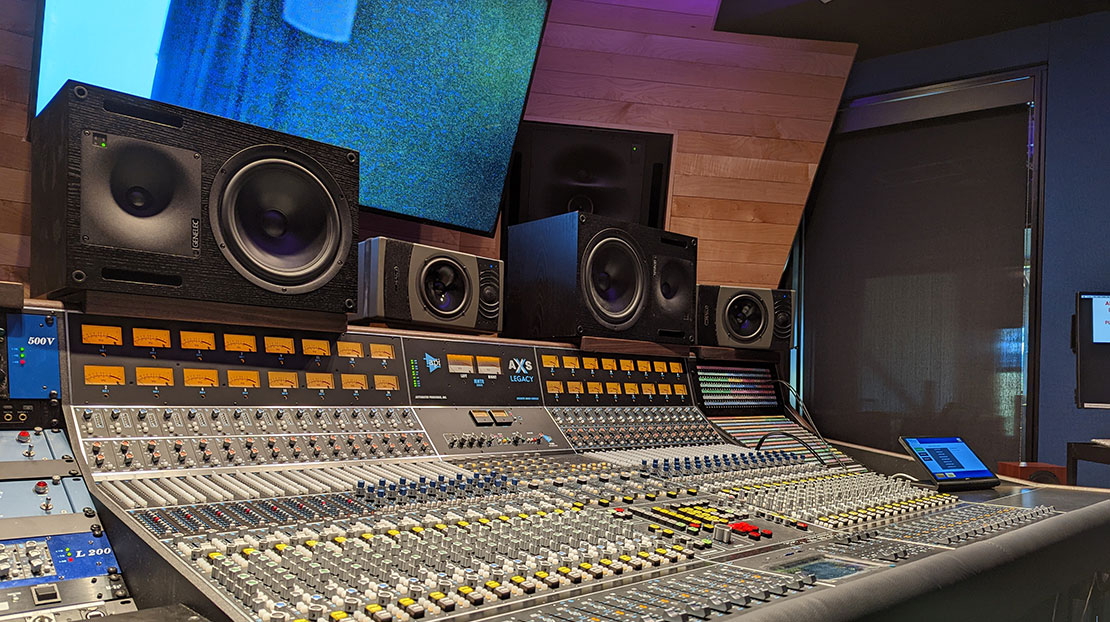
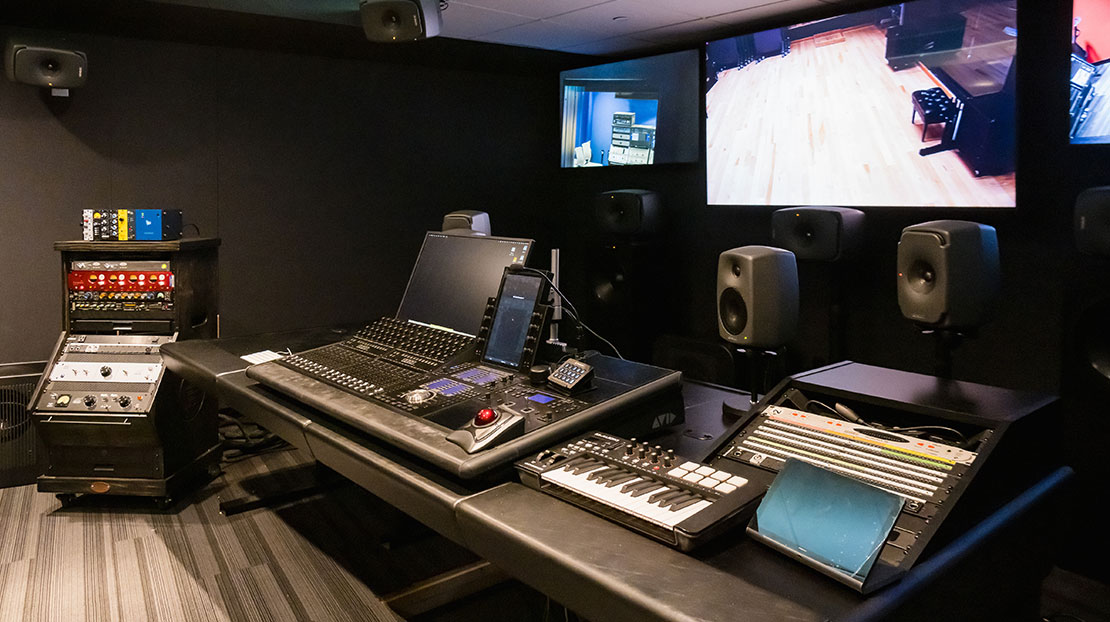
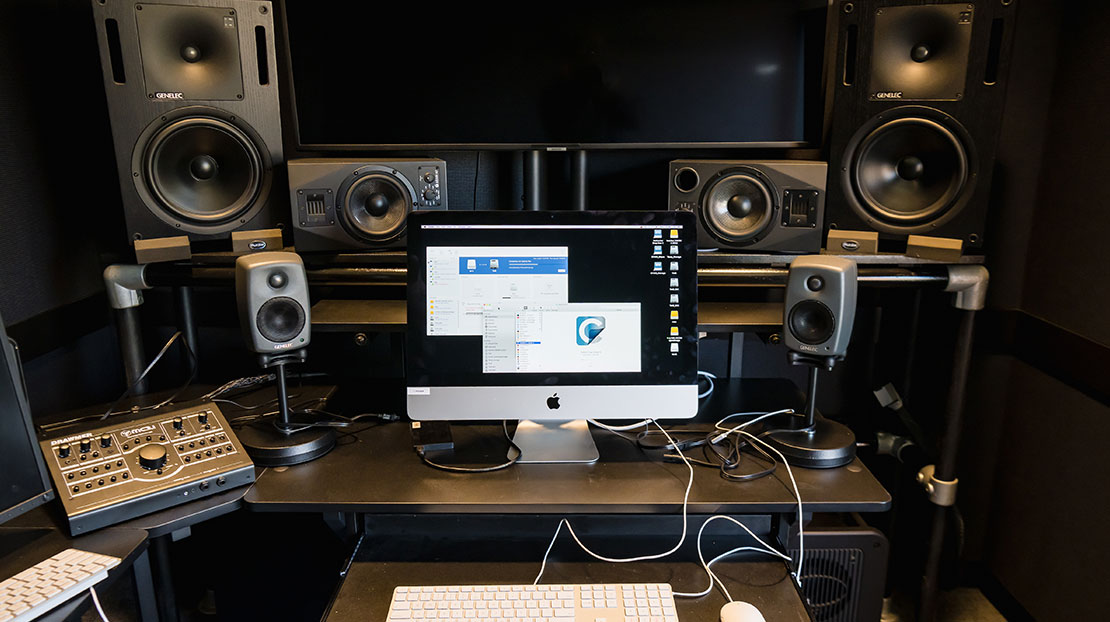
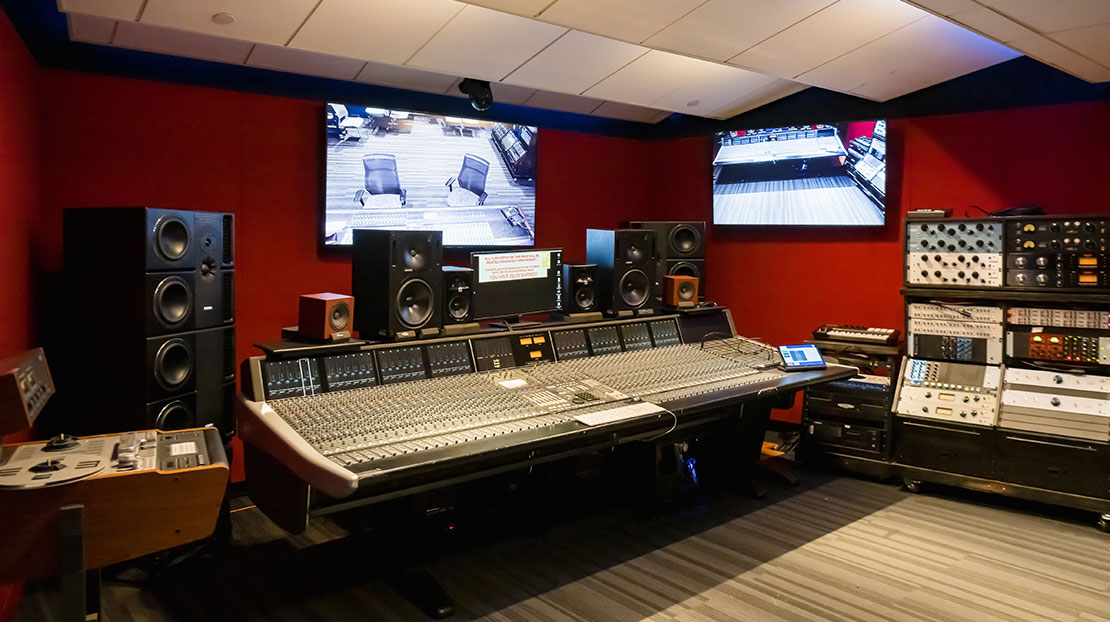
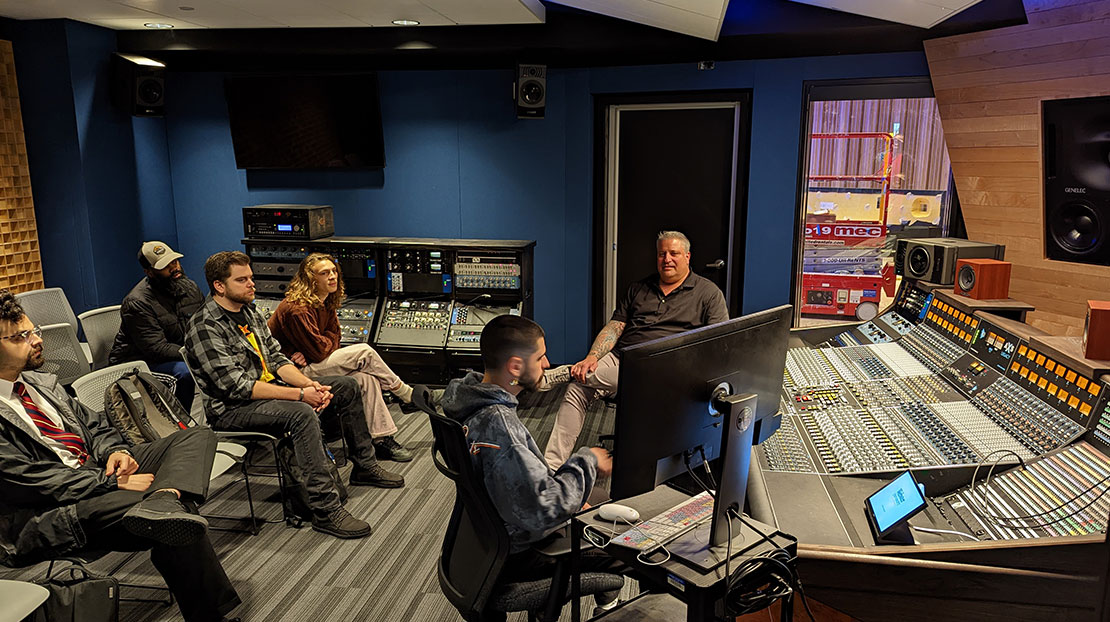
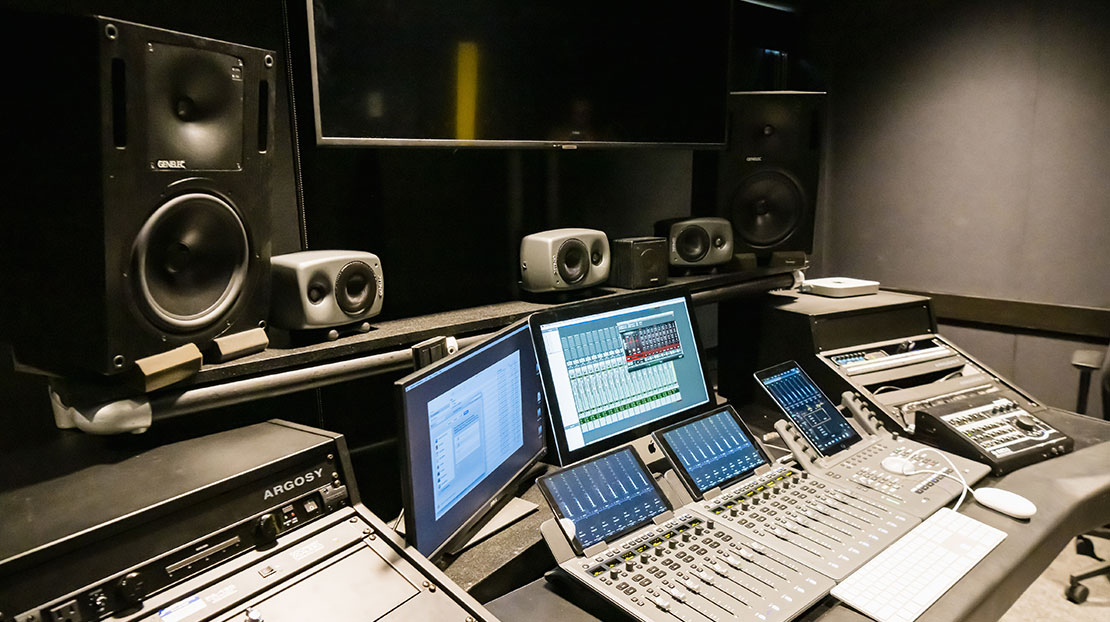
A new workshop for scene and model building, practical effects, prop creation, game prototyping and circuit testing for desktop fabrication, gaming, film and audio production.
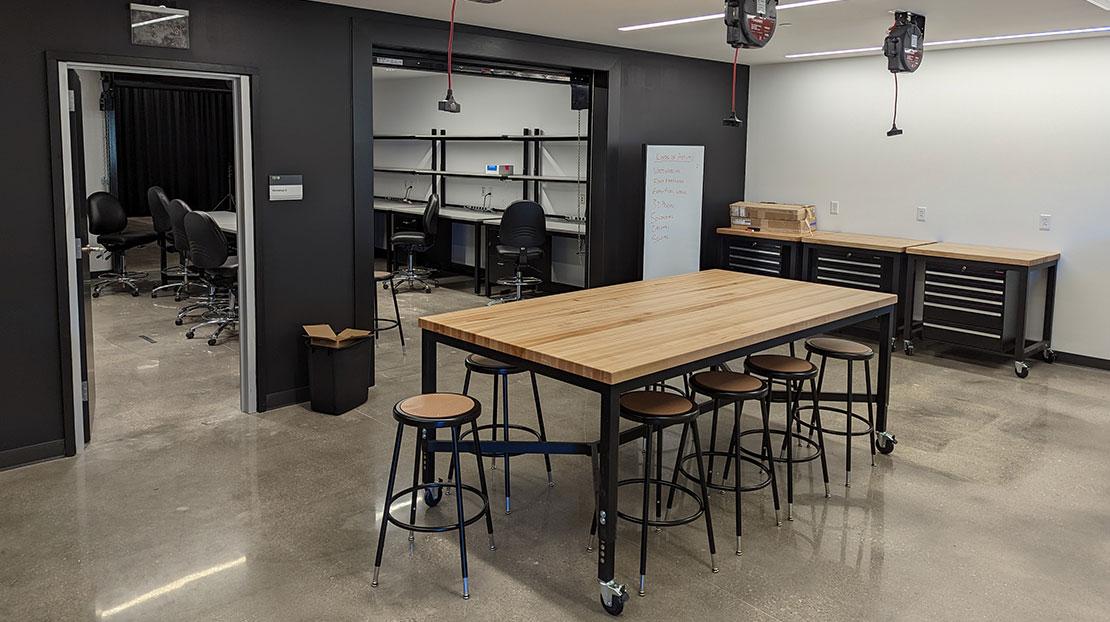
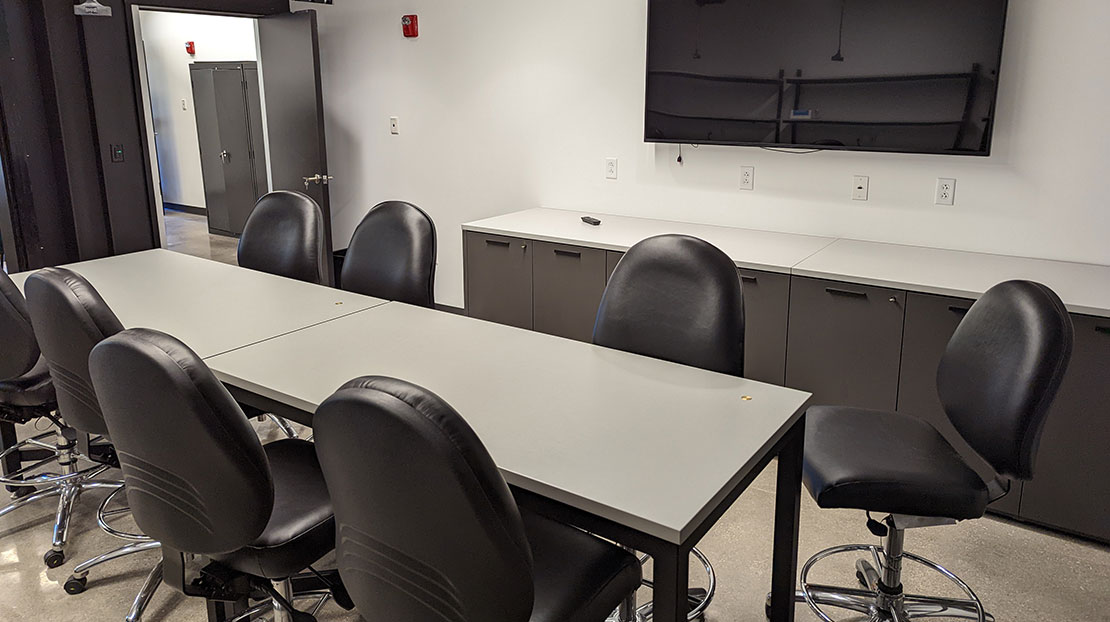
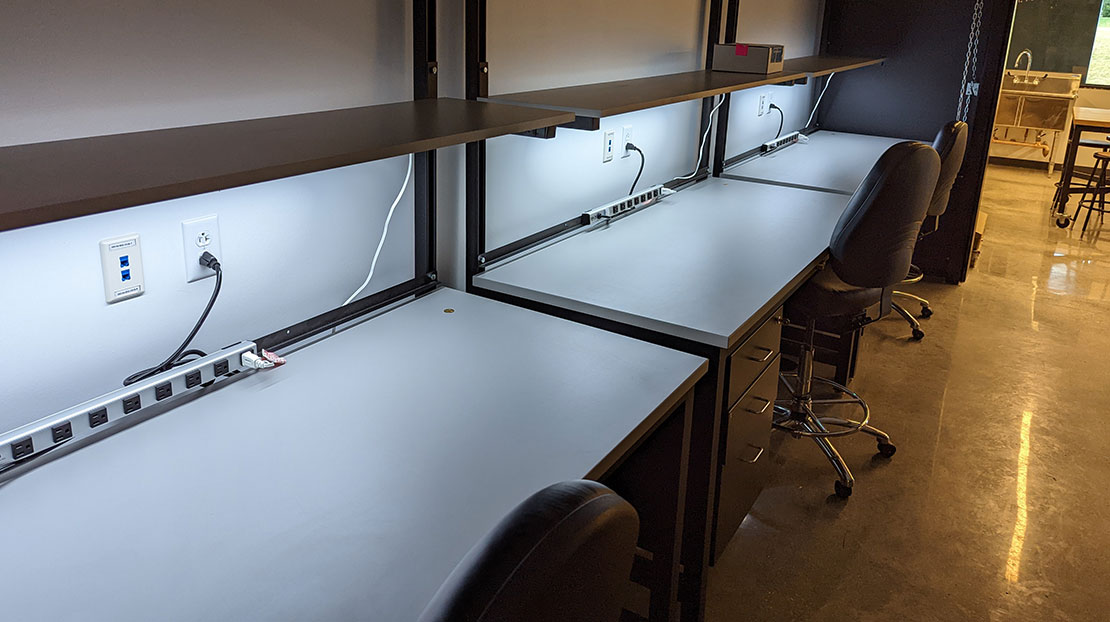
Labs for video, animation, game design, interactive and photography work. An image and photo studio that supports that latest in digital photography.
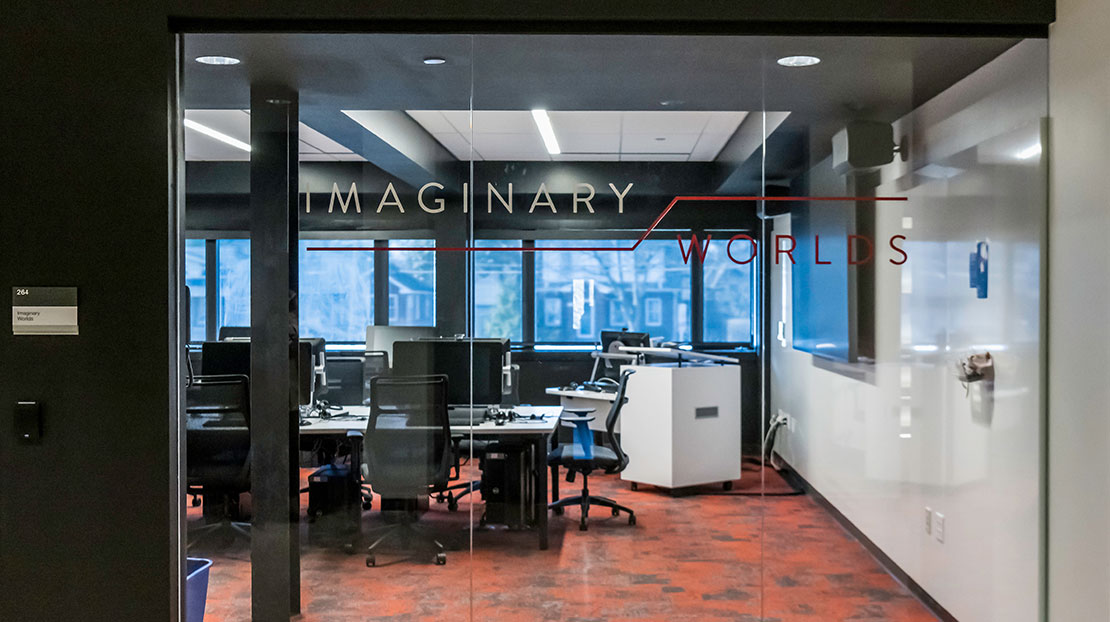
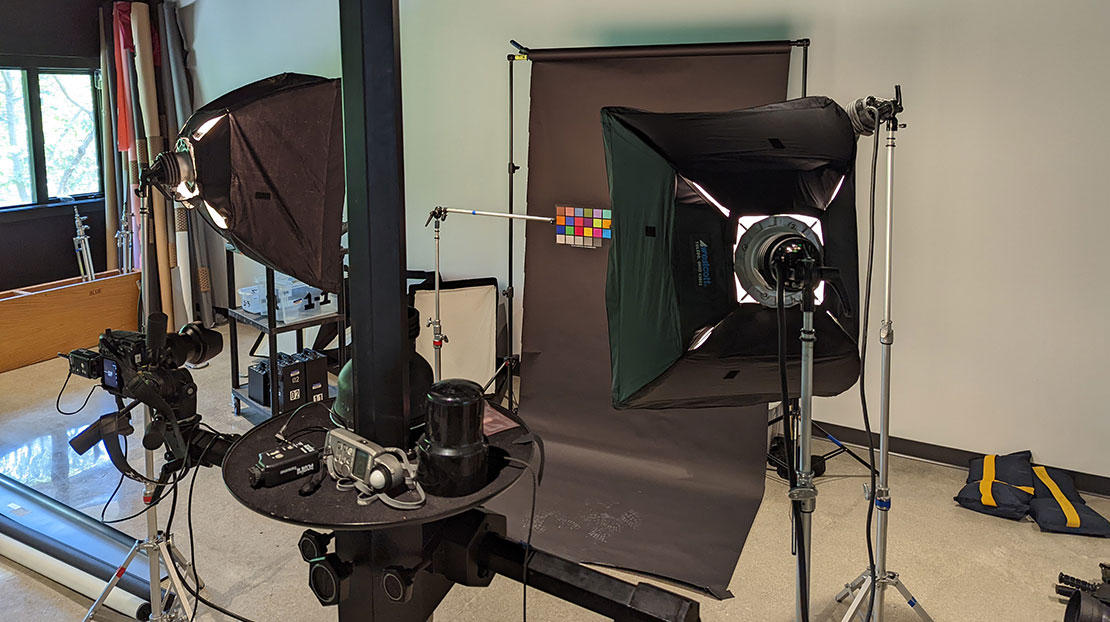
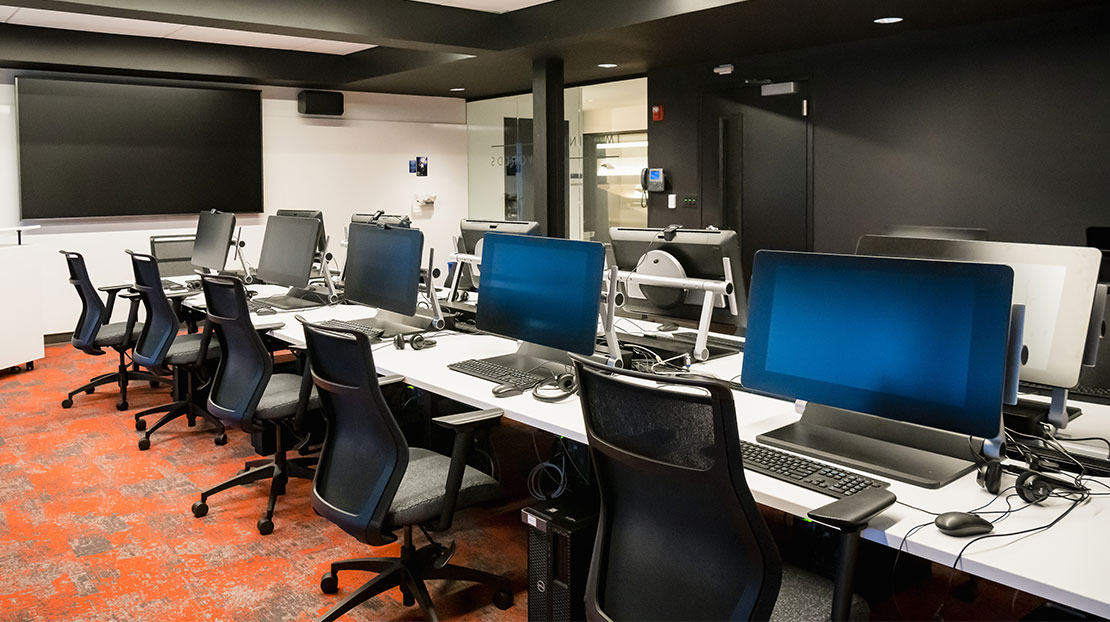
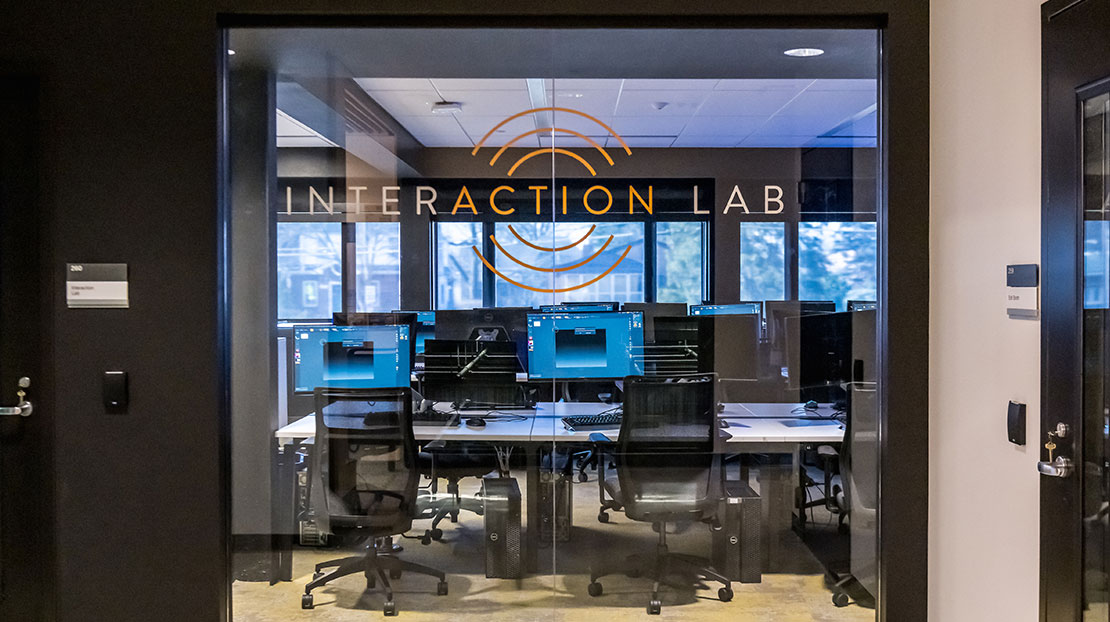
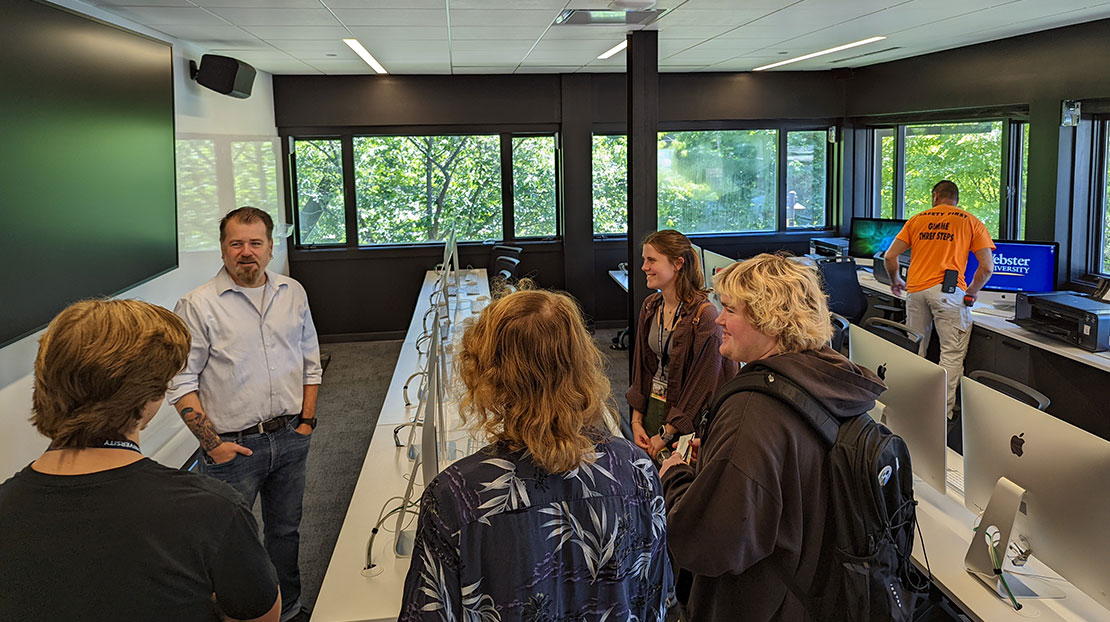
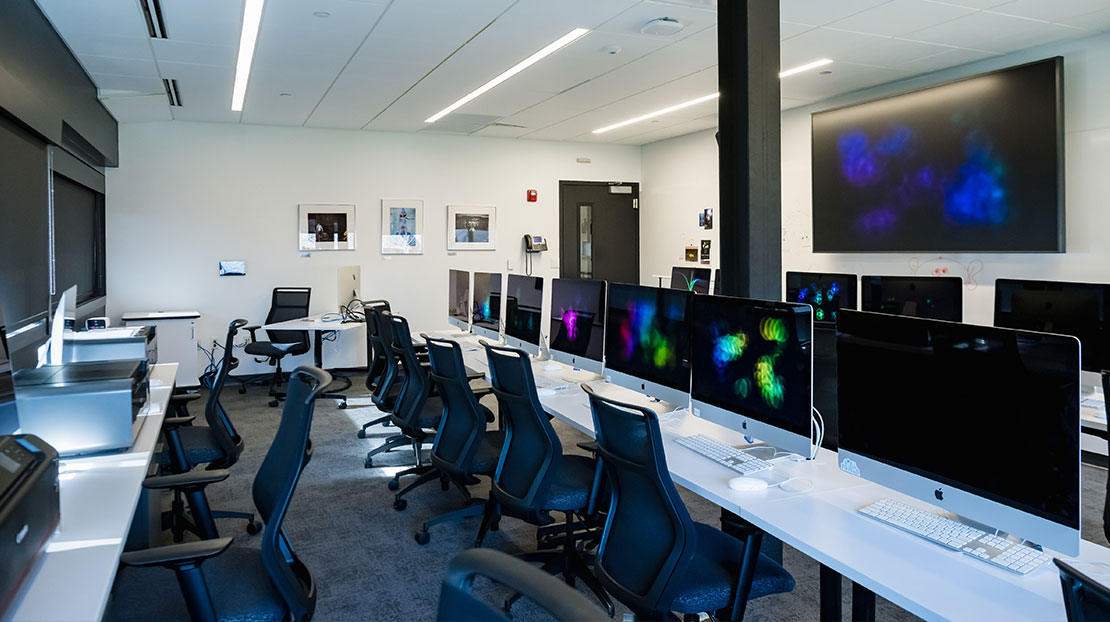
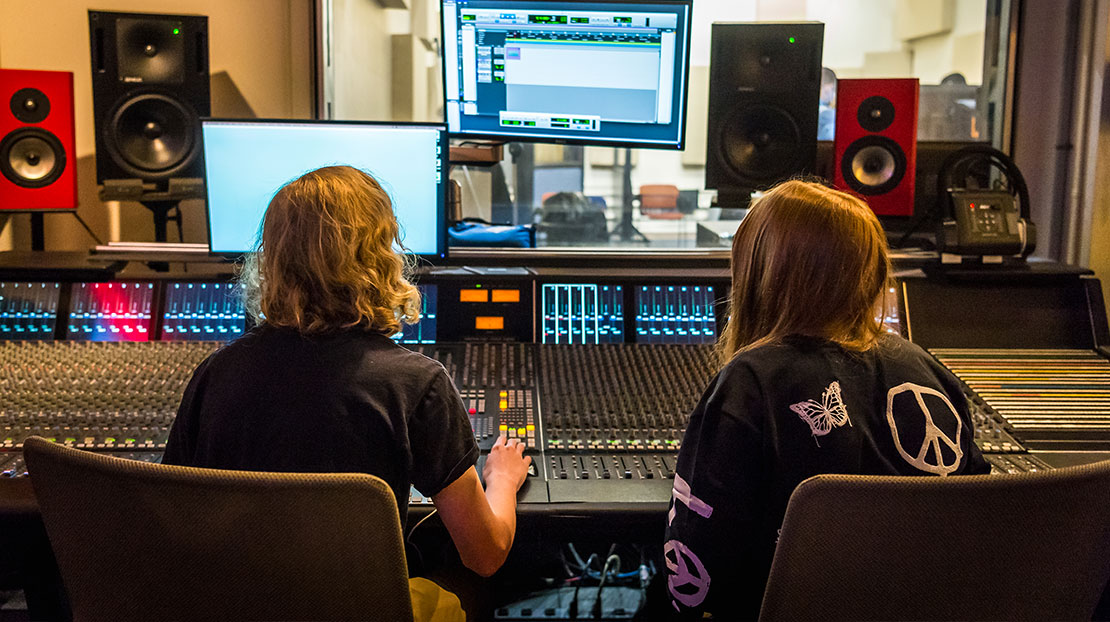
A new auditorium/screening room with acoustic treatment, surround sound and video conferencing.

Learn More About Our Communications Complex
Watch and learn as our very own Webster students, staff and faculty talk about the unique features and facilities available at Webster University.
Transcript
[A subway car with Eric Rothenbuhler, Dean, School of Communications holding onto a pole. He walks off subway car into the technology room that had simulated the subway car.]
Rothenbuhler: Hey, welcome to Webster University's School of Communications.
[Instrumental music plays.]
Text on Screen: Welcome to the School of Communications
[Rothenbuhler narrates over images of new renovated spaces such as classrooms, sound board studios, computer screens, views on campus, views of the open spaces inside the Sverdrup Technology Complex.]
Rothenbuhler: We have rehabbed a 66,000-square-foot building while we were still living and working in it. We've studied every detail and we've spared no expense.
Text on screen: Raven Hunter, Film Student.
Hunter: When I saw that the school was putting in all this money for new renovations it meant a lot to me.
Text on screen: Carl Nappa, Chair, Audio Aesthetics and Technology
[Nappa sits in front of a sound board.]
Nappa: Webster Places a premium on education and a technology that goes along with it is priceless.
[Instrumental music plays.]
Text on screen: What’s New in Sverdrup?
[Theater seats with screen light up in front with Webster logo. Rothenbuhler talks to audience while images of cinema, computers screens, sound boards, etc.]
Rothenbuhler: This phase of the spirit of remodeling project converted an entire wing of our building to a state-of-the-art production facility equipped with an LED video wall for a virtual cinema production, a state-of-the-art audio suite designed and built by folks who do this all over the country for professional recording facilities.
Text on screen: Aaron AuBuchon, Associate Dean, School of Communications
AuBuchon: This renovation means everything to us because our students and our students’ success means everything to us.
[Rothenbuhler narrating while a variety of classrooms, students, production activity and collaboration images are shown.]
Rothenbuhler: The second floor of this remodeling includes computer labs and classrooms for video post-production; animation; game design; 2D photography and graphic work; a photo studio and a beautiful, beautiful photography gallery, the Kooyumjian Gallery.
Text on screen: Rhiannon Blattel, Game Design Student
[A variety of images of students, professors, the cinema screen, computers screens, sound boards.]
Blattel: This classroom is actually one of the first ones I went into and like the dual monitors - I thought it was super cool.
AuBuchon: We've always attracted the kinds of students who wanted to get a quality education in media production and communications. Now we have the facilities and equipment to match the instructions.
Text on screen: Video Wall
[Images of the video wall with examples of images and measurements, and geometric symbols.]
Rothenbuhler: We have a fully equipped industry-standard sound stage.
Text on screen: Caleb Sawyer, Adjunct Professor, Game Design
[Images of the newly renovated spaces such as classrooms, sound board studios, computer screens, views on campus, views of the open spaces inside the Sverdrup Technology Complex.]
Sawyer: What a video wall does is allows you to build the setting for a scene whether you're making a movie, or a TV show, or just filming a video - and it lets you change the background of what you're doing so that through a camera lens positioned properly you could look like you are anywhere that the screen is.
Rothenbuhler: If you need a scene in New Zealand and another scene in New England, you can shoot both of those in the same day - there's no travel budget.
Text on screen: Francisco Jimenez, Film Student
Jimenez: Just knowing how to frame a camera or how to just set something up in a studio with an LED wall will have a big impact on making films in the future.
Text on screen: Simon Baker, Webster Alumnus
Baker: This is giving you the chance to really sink your teeth into more narrative and bigger studio work that a lot of people don't get the chance to.
Text on screen: Gerald Burton Jr. Journalism Student
Burton: This is my first time ever being in this area and just stepping into it kind of makes me think just how much more creative I can be.
[Renovated classrooms, studios, computer screens, campus settings, views of the open spaces inside the Sverdrup Technology Complex are shown.]
Text on screen: Kyu Park, Associate Professor, Film, TV and Video Production
Park: Every day I walk into the studio, I'm like, so we have this now here, right? This is just unbelievable. We really want our students to go above and beyond the basics, above and beyond the fundamentals.
[Instrumental music plays.]
[Images of sounds boards and audio technology.]
Text on screen: Audio Suites
Text on screen: Carl Nappa, Chair, Audio Aesthetics and Technology
Nappa: I learned in a professional recording studio, and so that's what we're building here: three professional recording studios to learn the ins and outs of acoustics, signal flow, all of those type of things. Our audio program is phenomenal, world class, and now we have a world-class facility that goes along with it so that when you leave here, you can take what you learned and do it just about anywhere in the planet.
[A variety of images such as soundboard and studios, computers, and views of students and professors in the open spaces inside the Sverdrup Technology Complex are shown.]
Text on screen: Parker Guterman, Audio Student
Guterman: I'm most excited about the “atmos” room the surround sound Studio B. It's got a bunch of crazy speakers and you can fly things all around the room, and it'll sound really cool.
Text on screen: Collaboration
Text on screen: Julie Smith, Instructor, Media Studies, Communications and Journalism
Smith: The workplace in today's environment is very collaborative and energetic and engaging and that's what we're training the students to do.
Blattel: Collaboration is very important especially with the game design classes that I take we're constantly looking at each other's screens and sharing information in order to build a game.
Burton: And I look forward to being a part of many different you know cool things and different productions and I'm ready to see what my fellow classmates are going to bring to the table as well.
Text on screen: Julia Griffey, Associate Professor, Interactive Digital Media
Griffey: The white boards all over the building. It's a wonderful way for students to collaborate. We have so many creative kids and you see the illustrations that start to form and the funny things that are on the wall and, and the words of encouragement.
[Instrumental music.]
Text on Screen: Kooyumjian Gallery
[Images of the gallery walls with the hanging artwork displayed.]
Rothenbuhler: It was always an activity more than a space and now with the Kooyumjian. We have a purpose-built gallery space, a professional venue for exhibiting both the work of our own students and faculty and visiting artists. It's beautiful.
Text on screen: The Place to Be
Sawyer: The upgrade in technology has been huge especially in game design where the students are doing a lot of their work on the computers, having those tools and putting them in a nice place to be, and making them easy to access is kind of priceless.
Text on screen: Julie Smith, Instructor, Media Studies, Communications and Journalism
Smith: We are training students for jobs that might not even exist yet and this new phase of the Sverdrup building is a great sign of our dedication to them and our commitment to them so that they can learn with the best and most recent technology available.
Hunter: They care about what you want to do with your career and where you want your life to go.
Narrator: So knowing that all these different medias and different outlets of expression and creativity are being supported by the school means everything.
Rothenbuhler: This remodeling has been a 10-year project. We have now one of the best facilities anywhere in the country. Now is the time for students to come to the School of Communications at Webster University.
[Instrumental music plays.]
Text on screen: Webster University Logo
Hands-On Learning and Media Equipment Center
Webster students receive hands-on learning in environments that reflect the cutting-edge technology being used by the top communication companies in the world. Faculty and staff worked closely with the architects and engineers to ensure that spaces reflected the leading edge of industry and would give our students a significant advantage in their chosen fields after graduation.
Webster University is investing in the future of our students to prepare them for the exciting, ever-changing field of communications, including its constantly evolving equipment. The School of Communications’ Media Center offers students access to more than $2 million inventory of professional grade media production equipment.



Access to equipment gives our students experience using professional-level equipment and facilities in audio production, animation and film and video production. Students work with state-of-the-art equipment as early as their freshman year. The School of Communications evaluates equipment needs on an ongoing basis. Students work with a range of tools to better prepare them for the variety of equipment they may find in the professional world. The school invests in state-of-the-art technology and teaches students the latest techniques, so they are ready for their chosen professions after they graduate.
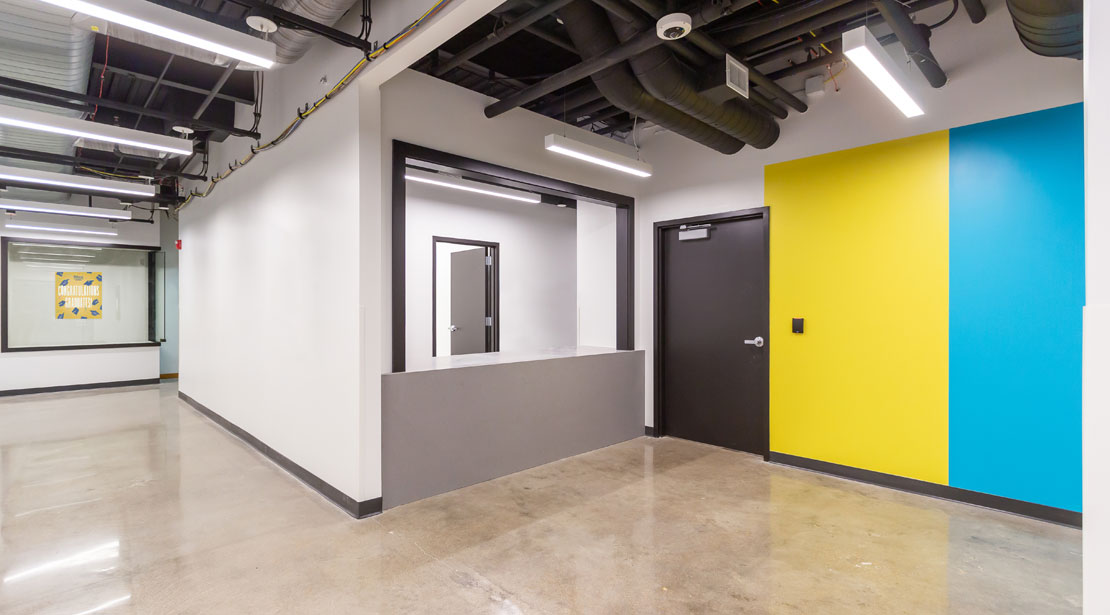
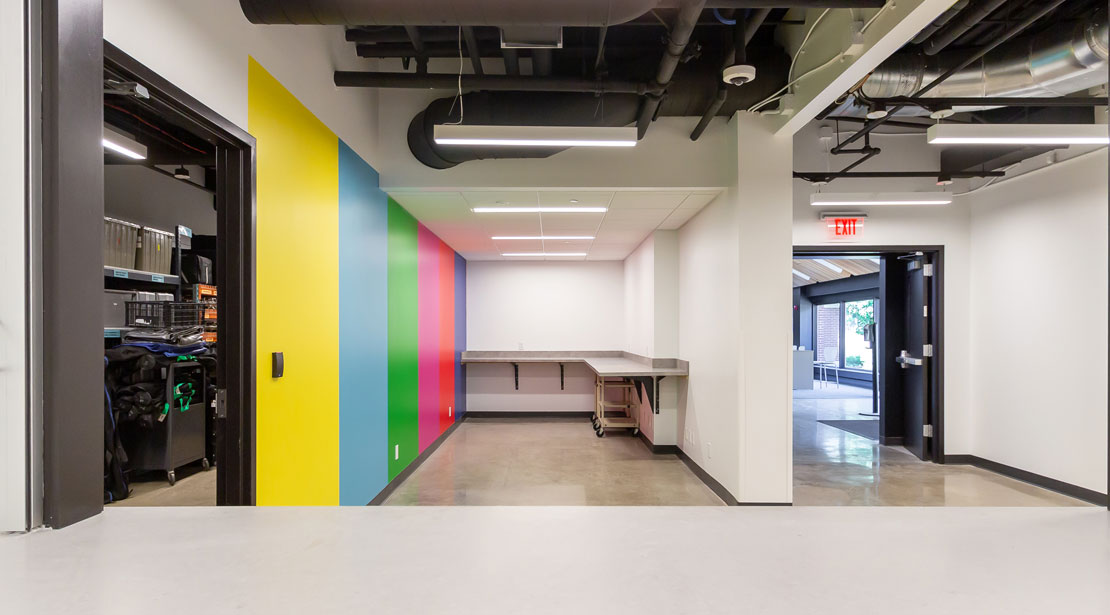
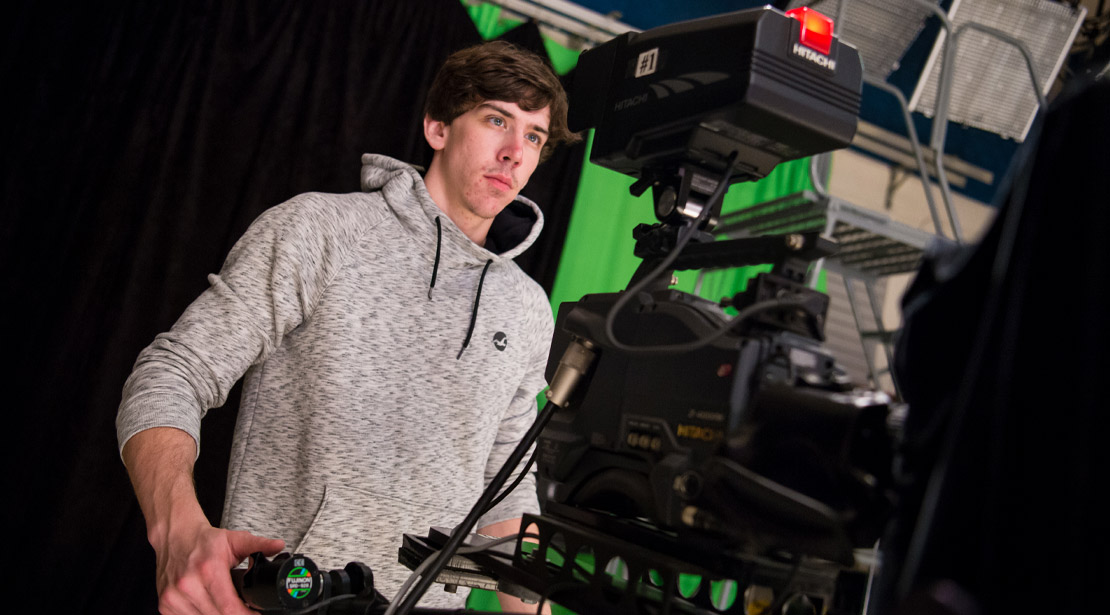
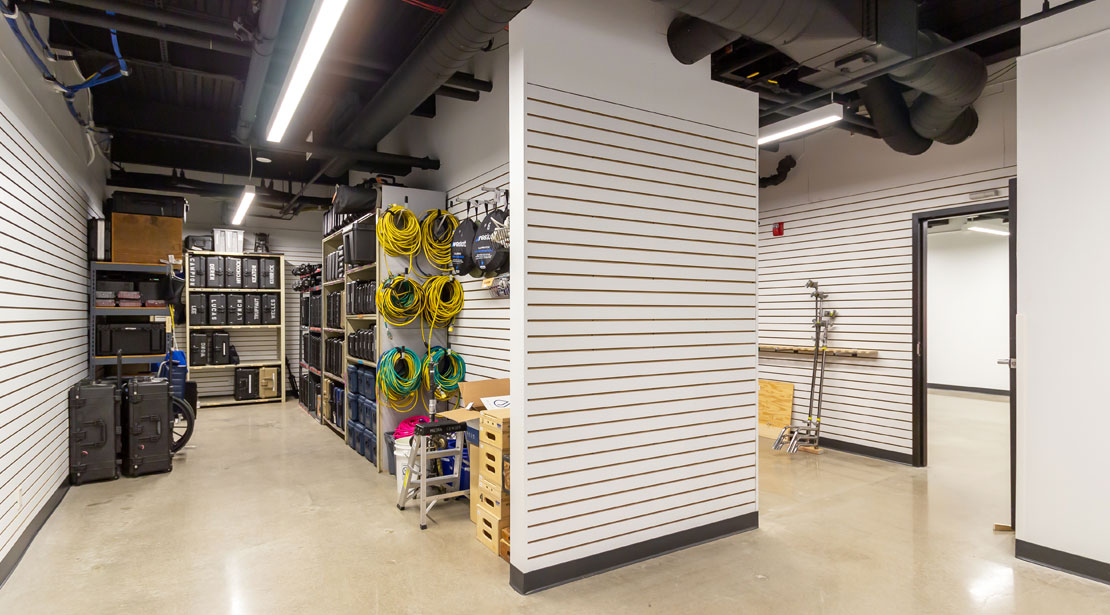
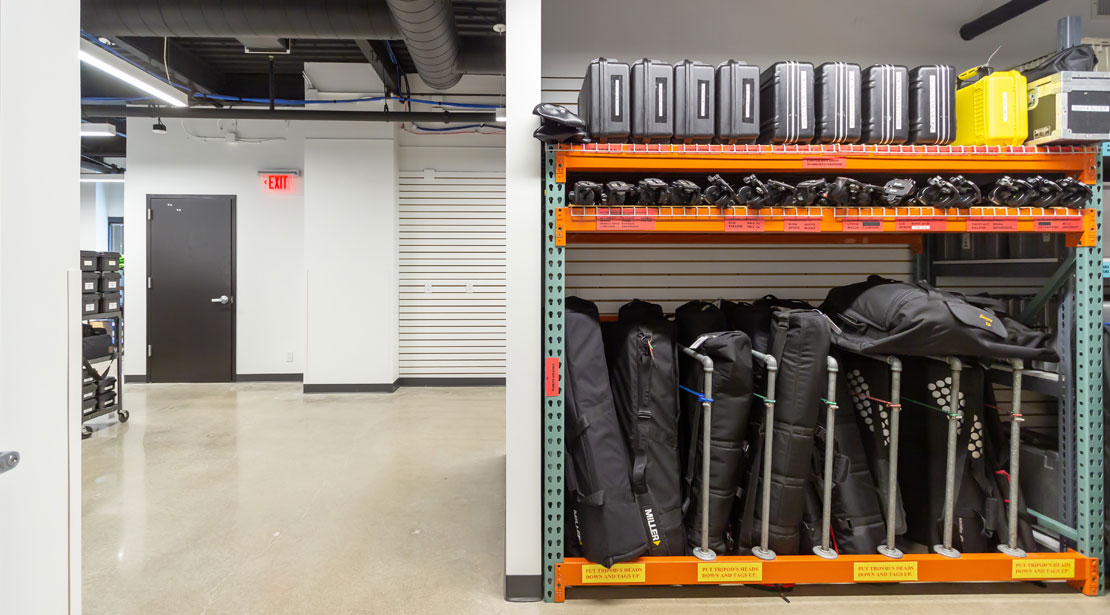
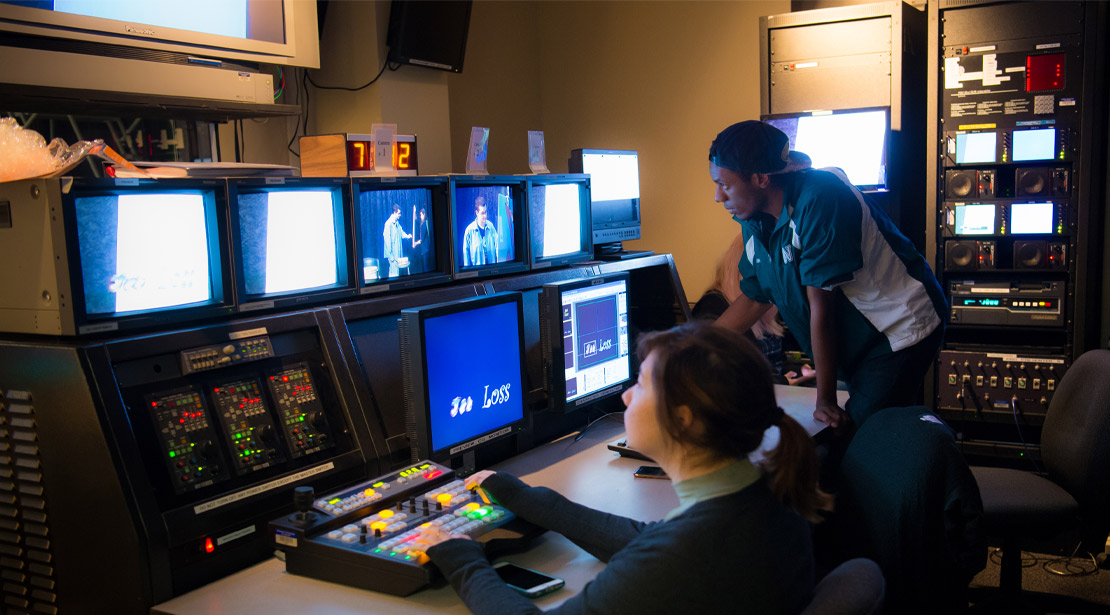
Winifred Moore Auditorium
The Winifred Moore Auditorium is one of the main venues on the Webster Groves Campus for concerts, film screenings, lectures and other large events. The auditorium's rich history adds a layer of intrigue as students, faculty, staff and guests gather for a wide range of events.
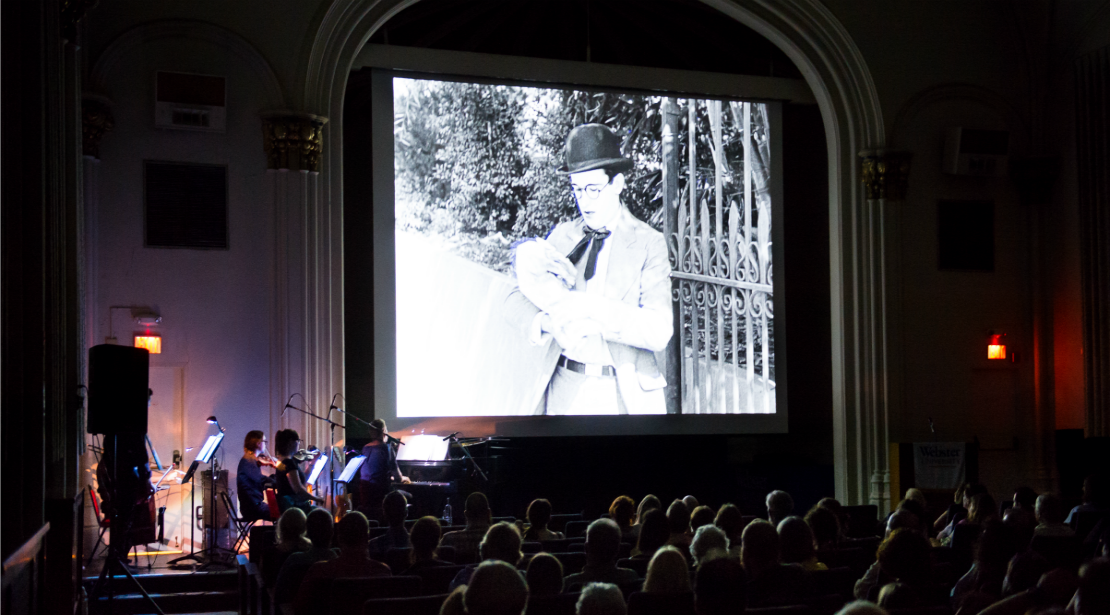
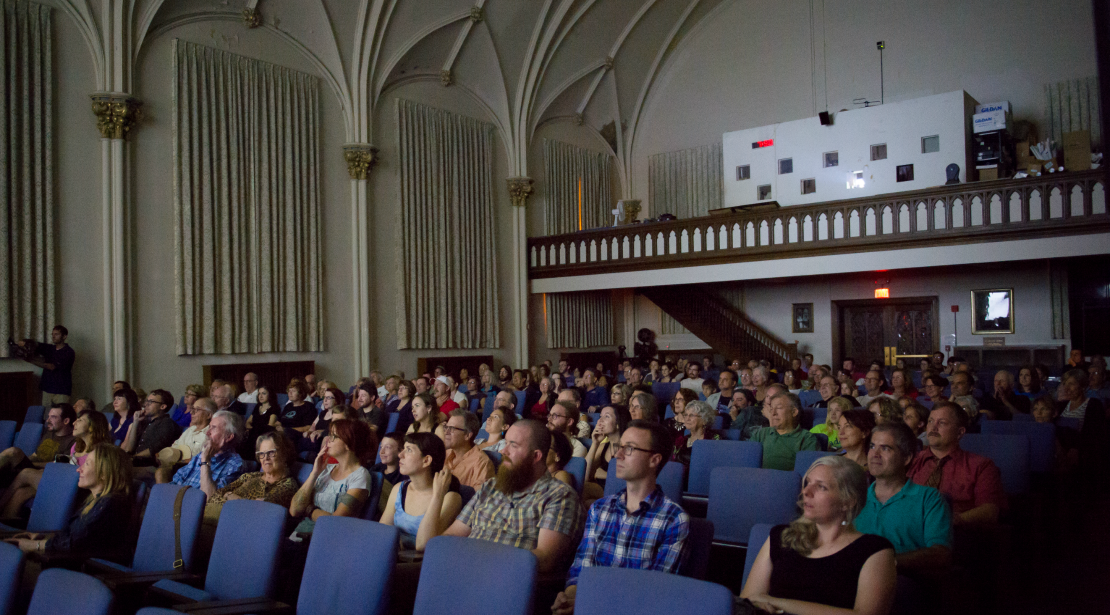
Winifred Moore was called the Chapel of All Saints, with daily mass and various ceremonies until the University transitioned to a lay board and became a secular institution in 1967. The chapel began to be increasingly used for a variety of other purposes, from musical performances and film showings to lectures, meetings and even yoga.
A grant from the Kresge Foundation provided much of the funds for an extensive renovation of the space which was completed in 1973. The chapel was renamed Winifred Moore Auditorium after it was renovated with gifts from Winifred W. Rogers and Elizabeth D. Hyatt in memory of their mother and grandmother, Winifred Moore.
Professional Learning Environment That Supports Creativity and Innovation
School of Communications facilities support our faculty and students in pursuing the highest quality media and communication work in the region and give our students important professional advantages in their post-graduation life. We provide students with a professional environment designed to support creativity and multimedia, as well as interdisciplinary work, mirroring the top companies in the industry. Our school is equipped with numerous open meeting and teaching spaces that encourage collaboration. Full networking capability is available in every room, internally and externally.
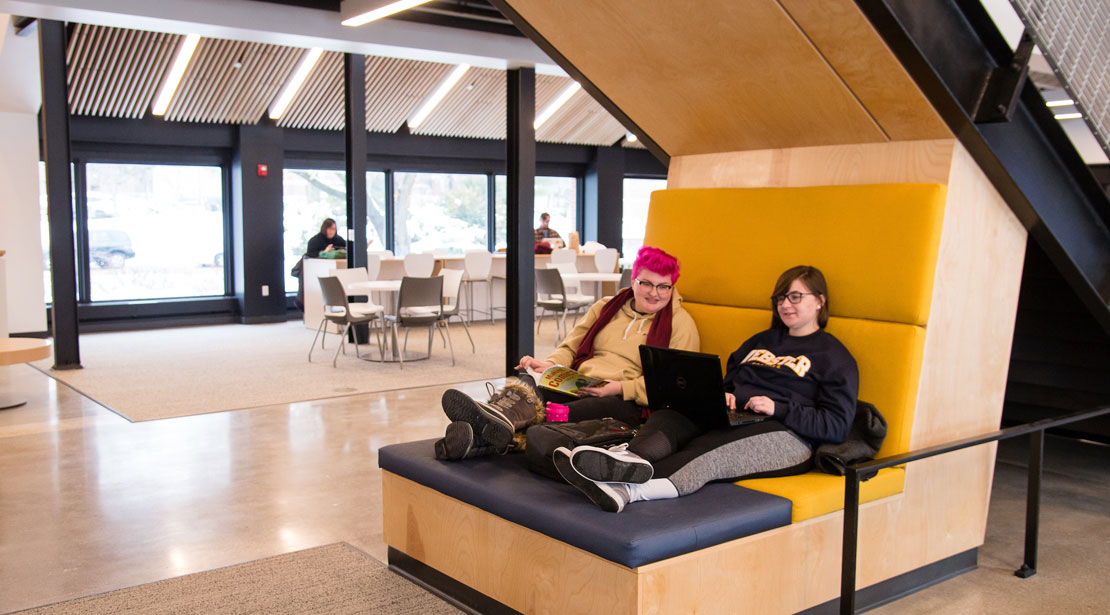
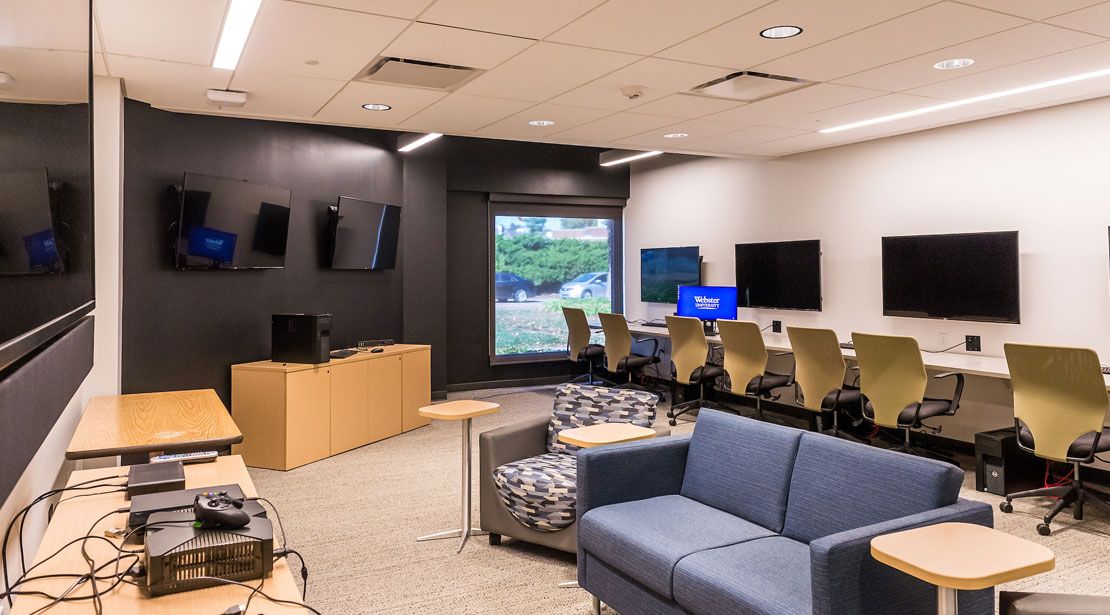
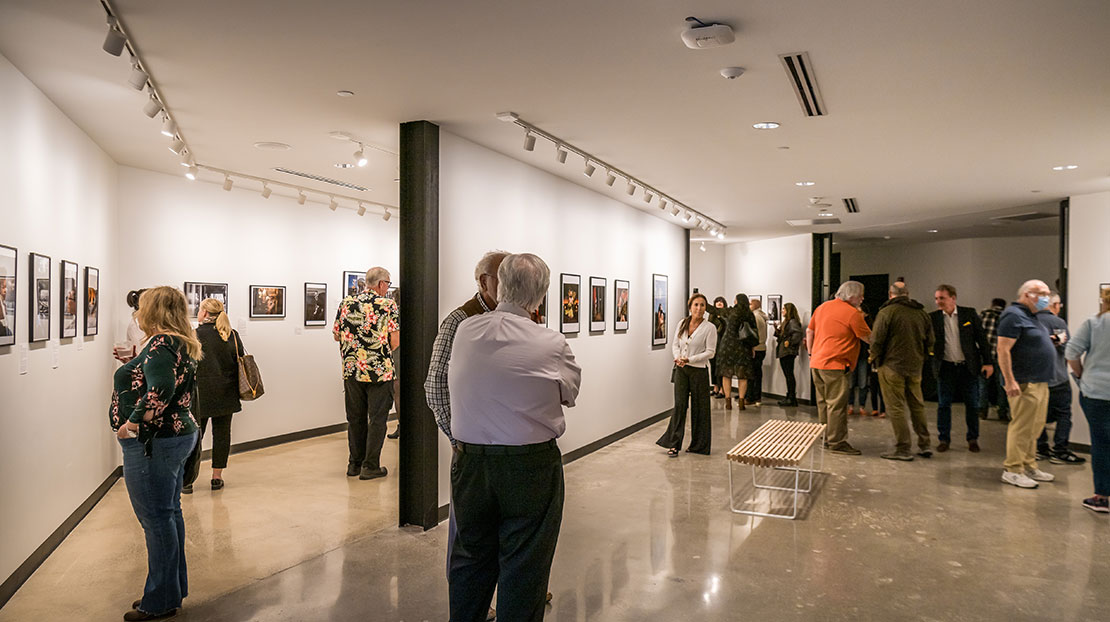
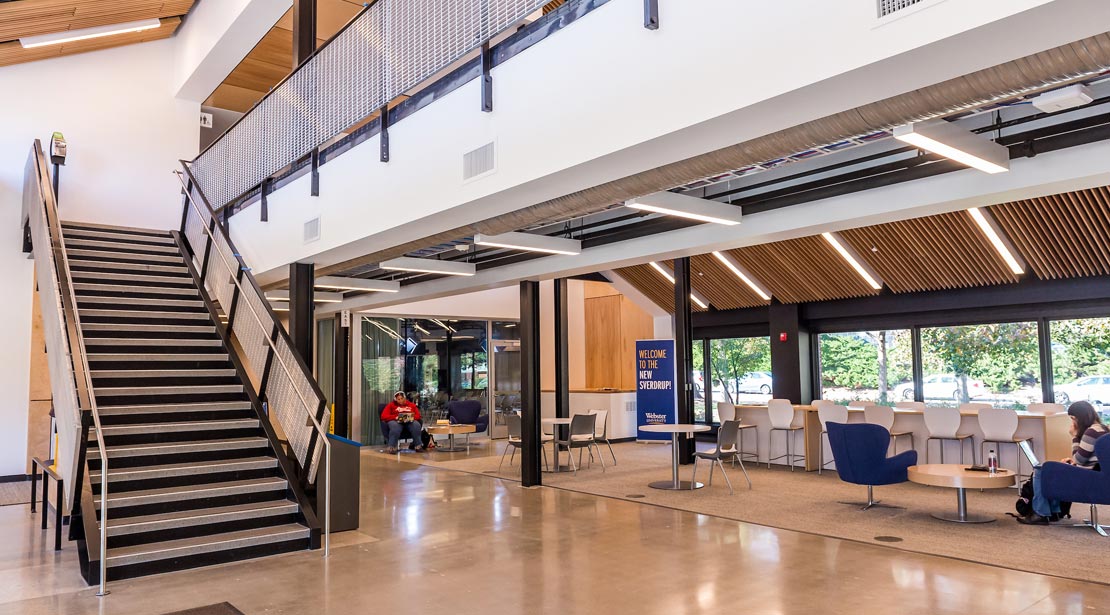
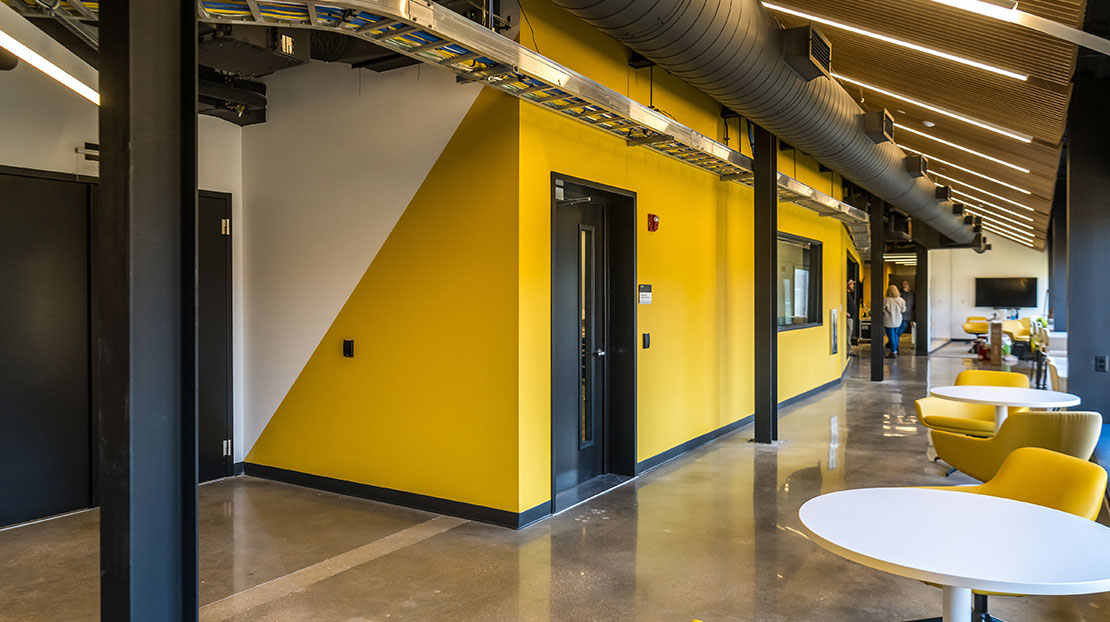
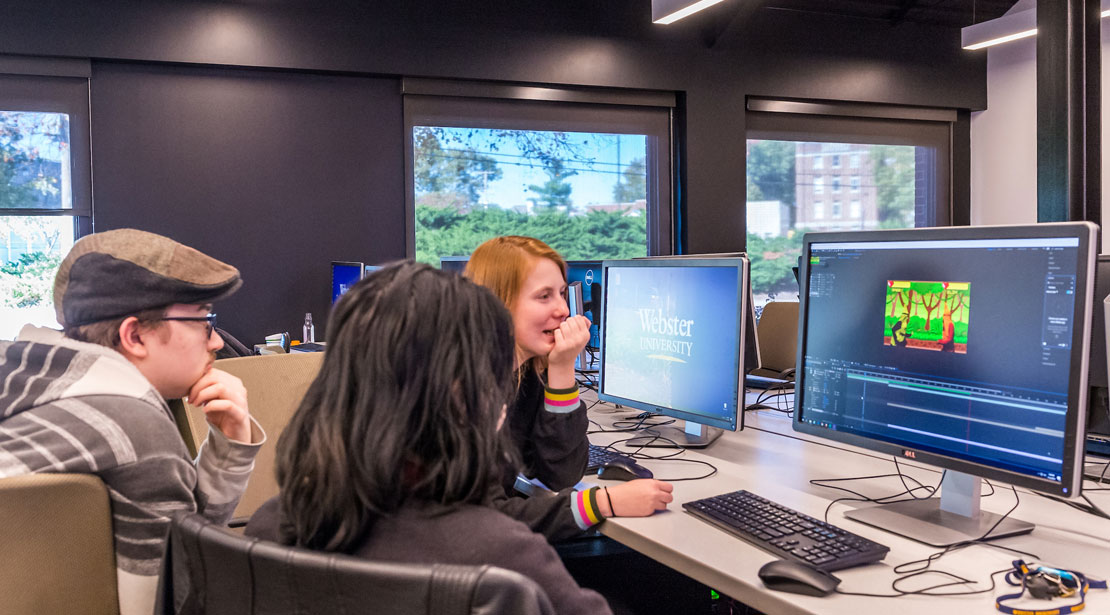
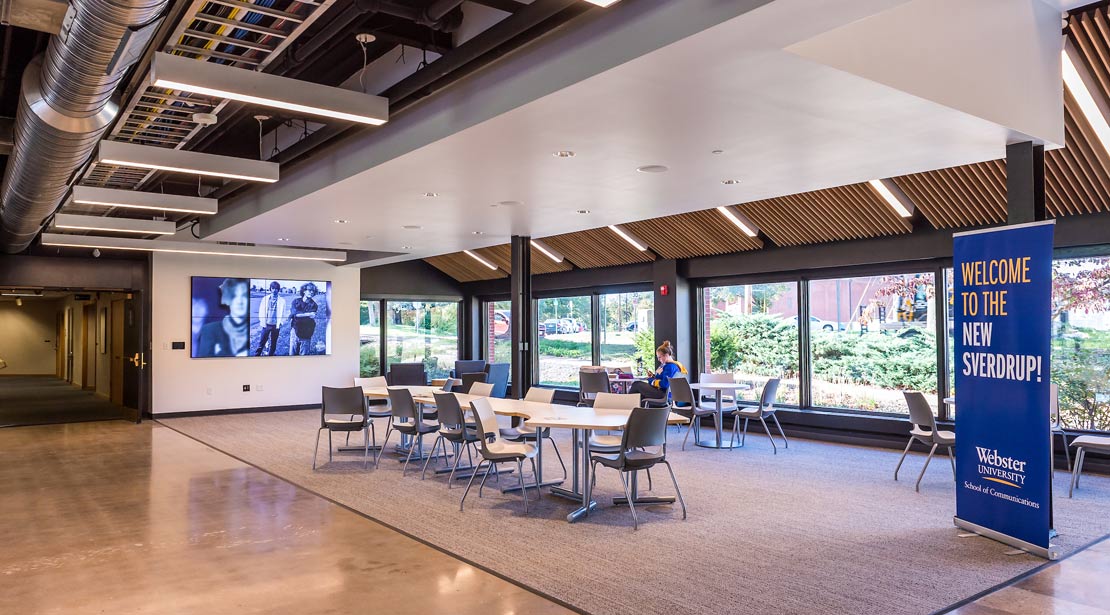
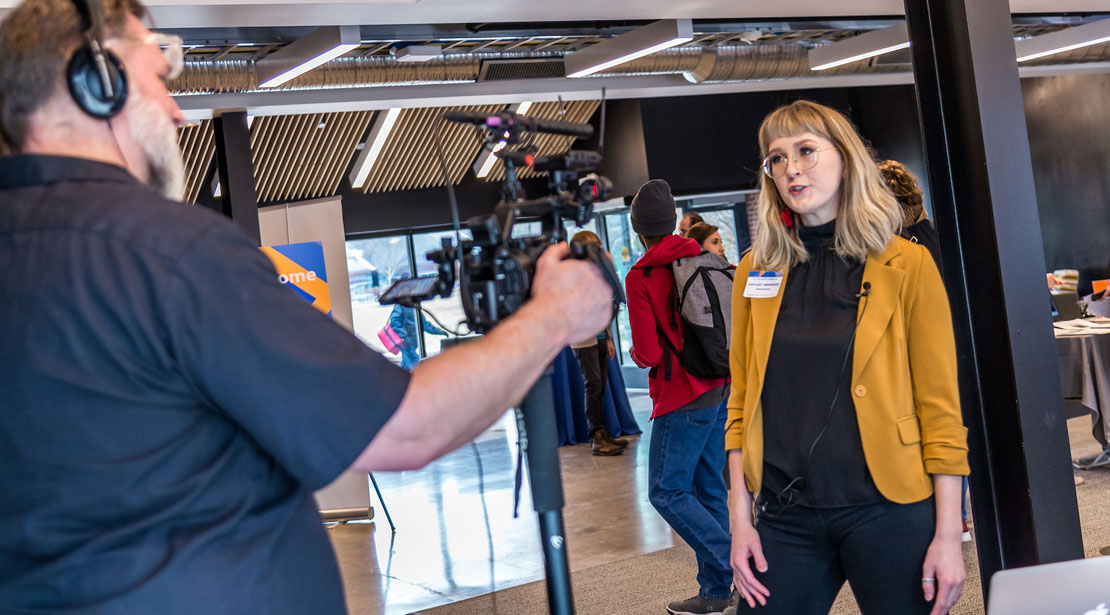
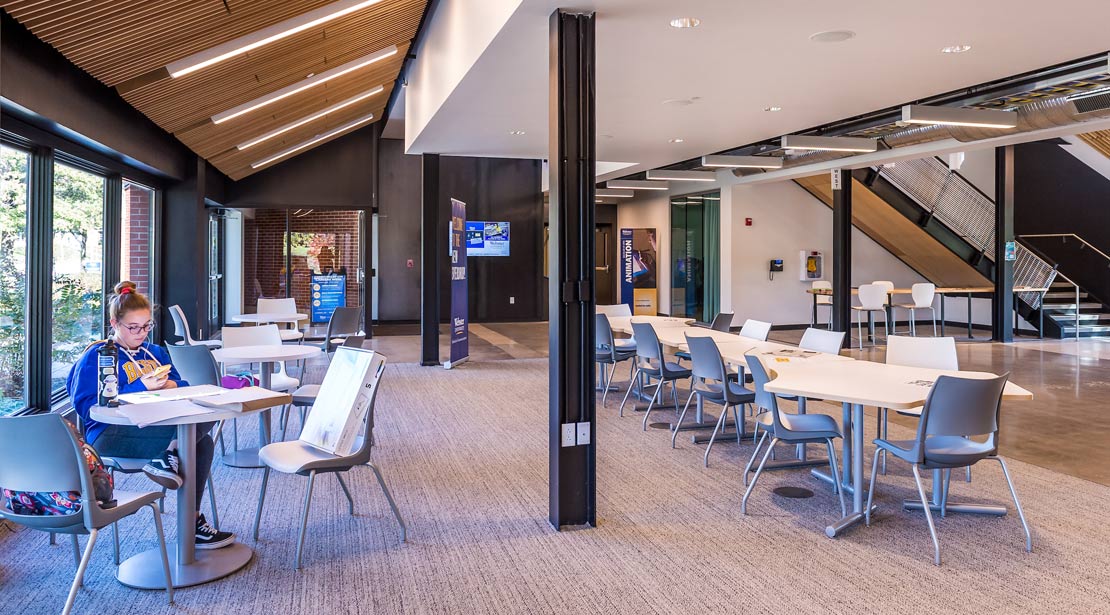
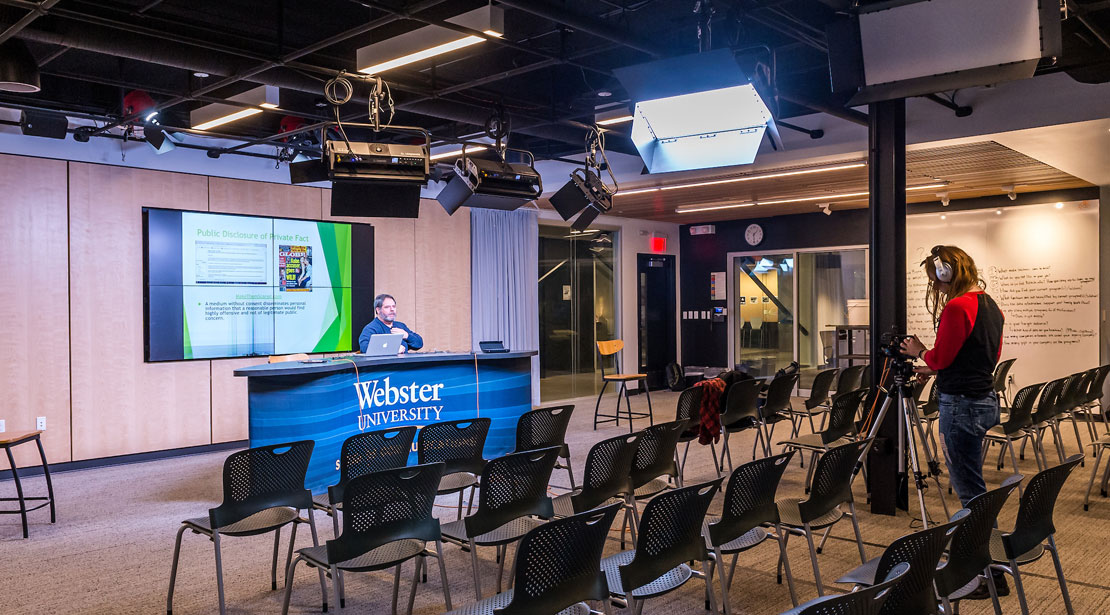
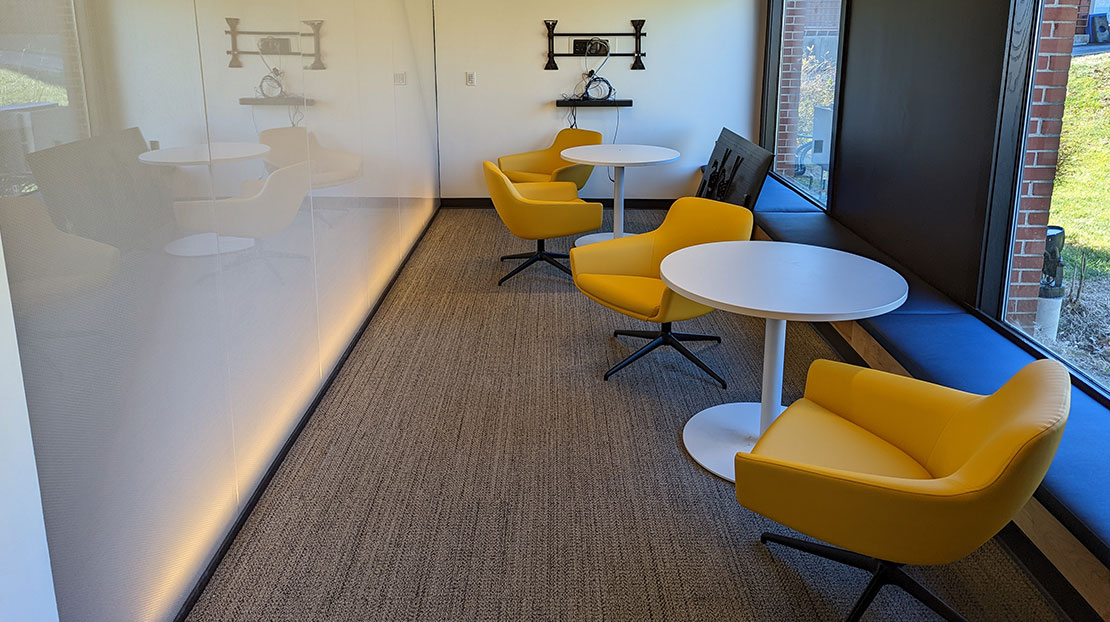
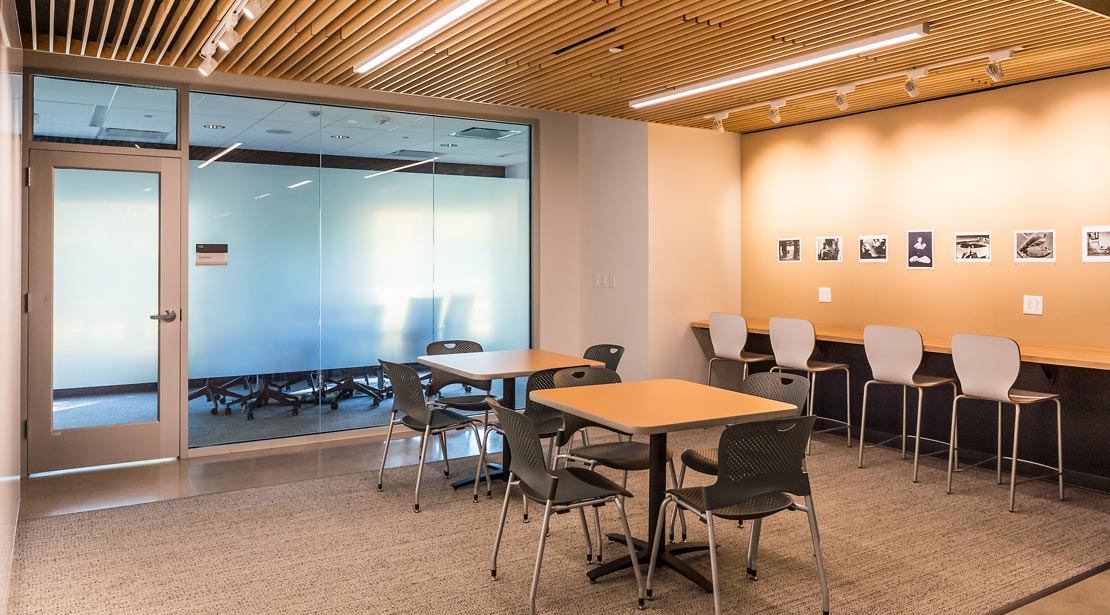
The Kooyumjian Gallery
In addition to studios, labs and classrooms, the School of Communications includes the Kooyumjian Gallery, continuing Webster’s three-decade tradition of photography exhibition and community engagement in its predecessor, the May Gallery. Established in 1988, the gallery is dedicated to showing photographic works by student, local, national and international photographers. Renovated and enlarged in 2022, the gallery events are always free and open to the public. Visitors can find the Kooyumjian Gallery in the School of Communications, second floor, west wing.

Connect with Us

In the News - Dec. 15 2025
December 15, 2025

In the News - November 4, 2025
November 4, 2025
Faculty and Staff Highlights: Bruce, Hoover, Martin, McMullen
October 13, 2025
Webster University faculty and staff highlights offer a roundup of recent Webster faculty and staff activity and achieve...
